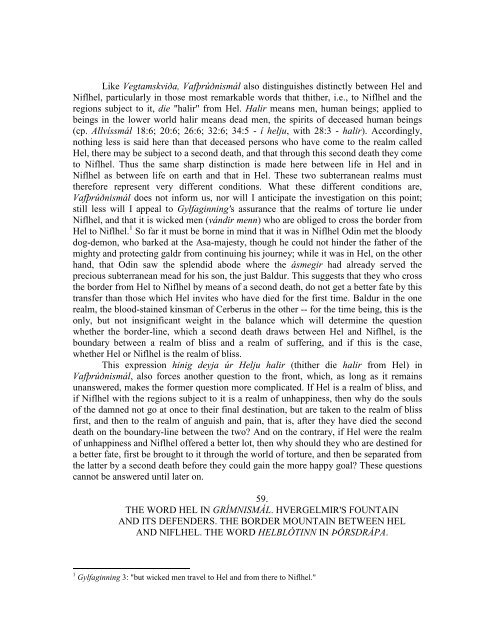Chapters 44-95 - Germanic Mythology
Chapters 44-95 - Germanic Mythology
Chapters 44-95 - Germanic Mythology
Create successful ePaper yourself
Turn your PDF publications into a flip-book with our unique Google optimized e-Paper software.
Like Vegtamskviða, Vafþrúðnismál also distinguishes distinctly between Hel and<br />
Niflhel, particularly in those most remarkable words that thither, i.e., to Niflhel and the<br />
regions subject to it, die "halir" from Hel. Halir means men, human beings; applied to<br />
beings in the lower world halir means dead men, the spirits of deceased human beings<br />
(cp. Allvíssmál 18:6; 20:6; 26:6; 32:6; 34:5 - í helju, with 28:3 - halir). Accordingly,<br />
nothing less is said here than that deceased persons who have come to the realm called<br />
Hel, there may be subject to a second death, and that through this second death they come<br />
to Niflhel. Thus the same sharp distinction is made here between life in Hel and in<br />
Niflhel as between life on earth and that in Hel. These two subterranean realms must<br />
therefore represent very different conditions. What these different conditions are,<br />
Vafþrúðnismál does not inform us, nor will I anticipate the investigation on this point;<br />
still less will I appeal to Gylfaginning's assurance that the realms of torture lie under<br />
Niflhel, and that it is wicked men (vándir menn) who are obliged to cross the border from<br />
Hel to Niflhel. 1 So far it must be borne in mind that it was in Niflhel Odin met the bloody<br />
dog-demon, who barked at the Asa-majesty, though he could not hinder the father of the<br />
mighty and protecting galdr from continuing his journey; while it was in Hel, on the other<br />
hand, that Odin saw the splendid abode where the ásmegir had already served the<br />
precious subterranean mead for his son, the just Baldur. This suggests that they who cross<br />
the border from Hel to Niflhel by means of a second death, do not get a better fate by this<br />
transfer than those which Hel invites who have died for the first time. Baldur in the one<br />
realm, the blood-stained kinsman of Cerberus in the other -- for the time being, this is the<br />
only, but not insignificant weight in the balance which will determine the question<br />
whether the border-line, which a second death draws between Hel and Niflhel, is the<br />
boundary between a realm of bliss and a realm of suffering, and if this is the case,<br />
whether Hel or Niflhel is the realm of bliss.<br />
This expression hinig deyja úr Helju halir (thither die halir from Hel) in<br />
Vafþrúðnismál, also forces another question to the front, which, as long as it remains<br />
unanswered, makes the former question more complicated. If Hel is a realm of bliss, and<br />
if Niflhel with the regions subject to it is a realm of unhappiness, then why do the souls<br />
of the damned not go at once to their final destination, but are taken to the realm of bliss<br />
first, and then to the realm of anguish and pain, that is, after they have died the second<br />
death on the boundary-line between the two? And on the contrary, if Hel were the realm<br />
of unhappiness and Niflhel offered a better lot, then why should they who are destined for<br />
a better fate, first be brought to it through the world of torture, and then be separated from<br />
the latter by a second death before they could gain the more happy goal? These questions<br />
cannot be answered until later on.<br />
59.<br />
THE WORD HEL IN GRÍMNISMÁL. HVERGELMIR'S FOUNTAIN<br />
AND ITS DEFENDERS. THE BORDER MOUNTAIN BETWEEN HEL<br />
AND NIFLHEL. THE WORD HELBLÓTINN IN ÞÓRSDRÁPA.<br />
1 Gylfaginning 3: "but wicked men travel to Hel and from there to Niflhel."
















